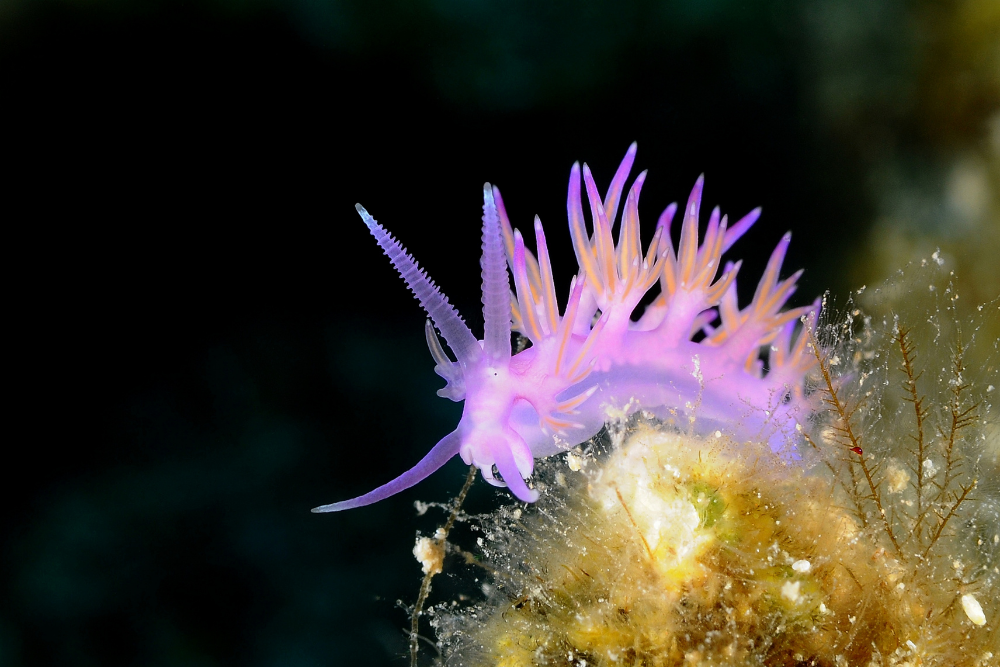If you are fortunate enough to have the opportunity to dive in New Zealand, you are in for a treat! New Zealand’s marine life varies from tropical, colourful reef fish and critters through to sharks, dolphins, sea lions and even killer whales.
Orca (Killer Whale)
If diving with Orca is on your bucket list, head over to the Poor Knights Marine Reserve where pods of orca are regular visitors. Although orcas are commonly referred to as ‘Killer Whales’, they are in fact harmless to humans and they are the largest member of the dolphin family. With their distinctive black and white patterning and huge dorsal fins, a pod of orcas powering through the waves is a truly impressive sight.

Bronze Whaler
The Bronze whaler is also known as the Copper Shark or its scientific name: Carcharhinus brachyurus. Bronze whalers are a large species of requiem shark and can reach up to 3.3 m (11 ft) long. Bronze whalers can be difficult to distinguish from other large requiem shark but they are characterized by their narrow, hook-shaped upper teeth, lack of a prominent ridge between the dorsal fins, and their plain bronze coloration.
In the summer months, bronze whalers live at relatively shallow depths over coral reefs – which leads to regular sightings. They do not pose a threat to humans unless provoked or mistaken, for example, they have been known to snap at spear fishermen carrying dead fish. The bronze whaler is the most commonly spotted shark species around New Zealand and it is thought to live for up to 30–40 years!
New Zealand Hooker Sea Lion
If you are diving around Aramoana, Dunedin, you might just catch a glimpse of the New Zealand Sea Lion, also known as the ‘Hooker’ sea lion after Sir Joseph Hooker, a botanist with a British Antarctic expedition which arrived in Auckland in 1844.
Adult males are more heavily built than females and are black or dark brown, and mature bulls have a mane of rough hair around their shoulders. Females are silver-grey dorsally and creamy coloured ventrally, although they appear pale brown when dry towards the end of the year. The pups are born with a thick coat of light or chocolate brown fur and measure a little less than 1m (3.2 ft) at birth. It is thought that males may live as long as 23 years and females as long as 18 years.
The New Zealand Hooker Sea Lion is listed as endangered and there are less than 10,000 individuals remaining. Fishing is their biggest threat. They can become caught and drown in fishing nets, and they have to compete for food with commercial fishers. Fishing vessels drag large trawl nets through the waters around the sub-Antarctic Auckland Islands at depths of around 200m (656 ft) to catch squid – at the same depths sea lions swim and hunt for food.

New Zealand Fur Seal
For divers around Kaikōura, South Island, the New Zealand Fur Seal is usually on their bucket list. The New Zealand Fur Seal spends a lot of time on rocky shores, especially during breeding season, when they return to the same site each year.
New Zealand Fur Seals are excellent hunters and divers. They dive for prey for up to 2 minutes and some have been known to reach up to 400m (1,312 ft). When they are not hunting, they can stay underwater for up to 14 minutes.
These seals are not endangered and their numbers in recent years have actually started to increase.
Black Coral at Milford Sound
Diving at Milford Sound is well known for its unusual marine eco-system. The top 10 meters (32.8 ft) of water are actually fresh water, coming from run off from the land. The run off is stained a tea-colour due to the tannins from plants and soil that it picks up along its way. This darker coloured water blocks out the sunlight from the lower salty layers of water, resulting in many of the marine species that are found in the shallows here actually being species that normally would be found at much greater depths. And these species include black coral which is usually found in deeper waters. There are around 7 million coral colonies in Milford Sound and they have been building their underwater forests here for around 200 million years – a sight definitely worth seeing!
Jason Mirabilis Nudibranch
The Jason Mirabilis nudibranch is found across New Zealand and it is highly sought after by underwater photographers. It is typical of an aeolid nudibranch which have a spikey appearance. The Jason Mirabilis displays a variety of colours and can usually be found among hydroids, on which it feeds.

Sperm Whales
Sperm whales are most frequently spotted in New Zealand around Kaikōura where males can be seen year-round and close to shore. They congregate here because the 3km (1.8 miles) deep Kaikōura Canyon has a rare system of sea currents that sustain an incredibly rich marine food chain. Sperm Whales are at the top of this food chain and the abundance of fish ensures the males stay in the area while they bulk themselves up. The females and young whales prefer to stay out in the tropical waters.
Sperm whales are one of the deepest diving whales, they usually dive hundreds of meters to find their food but have been recorded at depths of over 3,000m (9,842 ft)! They are also champion breath holders generally averaging dives of between 40-60 minutes but have been recorded at ‘holding their breath’ for over 2 hours.
Spiny Sea Dragons
If macro marine life and critters are more to your liking, then Milford Sounds, which is home to the Spiny Sea Dragon, should be on your list of places to dive in New Zealand. Spiny sea dragons are recognisable by their long spiny bodies, long snout, and their vibrant orange skin with yellow and pink stripes. Spiny Sea dragons are found all year round in Milford Sounds and they make incredible macro underwater photography subjects!
Dusky Dolphins
It’s not just sperm whales that enjoy the waters around Kaikōura, Dusky Dolphins are spotted here too. Dusky dolphins have virtually no beak, and their dorsal fin is not hooked and rather blunt. They are a bluish-black colour on the back and tail and white on the underside of the body.
Large groups of several hundred to over 1,000 dusky dolphins are present in Kaikōura all year round with individuals moving north to feed at Admiralty in winter months. Dusky dolphins interact with a variety of other marine mammals including common dolphins, long-finned pilot whales, bottlenose dolphins, New Zealand fur seals, sperm whales and orca – so they are in good company in Kaikoura!

These are just eight of our favourite species but, of course, there are countless other amazing marine species that you will encounter in all areas of New Zealand – we can’t possibly list them all here!
If you are keen to be wowed by all that New Zealand has to offer underwater the best way to see it is with your own eyes – so get ready to dive in! Locate a PADI dive shop in New Zealand and start crossing off seeing these bucket list marine animals.
by Adam Hanlon
Wetpixel member and contributor Burt Jones is appealing for “historical” image contributions to the Bird’s Head Seascape Manta ID database. Specifically, they are seeking images of mantas taken in Raja Ampat in 2009 or earlier.
The database already has over 1400 identified individuals. While mantas are protected within Raja, they are not in the rest of Indonesia. By showing that they have large migratory patterns, this can be used to motivate the government to institute protections nationally.
If you have images of mantas taken in Raja in or before 2009, here are the specifics: Low-resolution images of the animals’ bellies (this is where they have distinctive markings). The date the image was taken on and the dive site are also crucial. Please email any suitable images to Burt.
by Adam Hanlon
On Wetpixel Live, Wetpixel Editor Adam Hanlon and regular contributor Alex Mustard discuss the unique characteristics of Fotosub underwater photography contests. Sometimes known as Splash-Ins or Shootouts, these contests are a big feature of underwater imaging in some parts of the world, yet are often poorly understood and followed in English speaking countries.
If you enjoy this episode, please subscribe to the Wetpixel Live YouTube Channel. This will then notify you when additional episodes are posted in future. Wetpixel Live is crammed full of hard-edged technical information and practical advice aimed at helping people create memorable images.
Interesting Info
 Private Scuba Tuition – Learn Scuba Skills.
Private Scuba Tuition – Learn Scuba Skills.
Joey Ridge offers private scuba diving training for those who would feel more comfortable in a private one to one setting
Diving Services
- Beginner Diving
- Padi Recreational Courses
- Padi Technical Courses
- Professional Instructor Courses
- Dive Equipment Servicing
Contact Me
Contact: Joey Ridge
PADI Course Director
TecRec Instructor Trainer
Tel: +357 99676216
Whatsapp – Facetime – Skype



